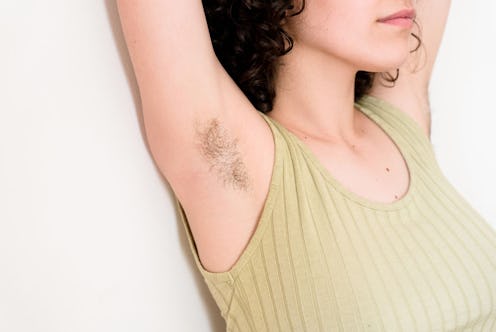
By now, most of the internet has witnessed Chrissy Teigen getting Botox injections for her armpits on Instagram, which according to the Lip Sync Battle host was "truly the best move I have ever made." And for those who have hyperhidrosis — which is, "abnormally excessive sweating that's not necessarily related to heat or exercise," as per Mayo Clinic — or just don't want to sweat from their pits, this cosmetic treatment may just leave them feeling the same way. However, it's important to be well-informed about the procedure before deciding to move forward.
Excessive sweating may not be ideal for most people, but according to Dr. Steve Fallek, board certified plastic surgeon and medical director at BeautyFix Med Spa, who regularly treats patients with hyperhidrosis, it's actually quite common. "An estimated 2% to 3% of Americans suffer from excessive sweating of the underarms," he tells Bustle, adding that the condition usually starts in the late adolescence years. Although having hyperhidrosis does not necessarily mean a person has an underlying medical issue, "excessive underarm sweating is still a significant problem for many people," Dr. Joshua Zeichner, director of cosmetic and clinical research in dermatology at Mount Sinai Hospital, explains to Bustle. Most of the side effects Zeichner has seen, due to more-than-average amount of sweat, are typically related to patients experiencing lower self-esteem.
Anti-perspirants have long been used to curb sweating, however, both MDs agree that Botox — which was approved by the FDA to treat perspiration in 2004 — may be a more effective long-term solution. "Normally the nervous system activates sweat glands when the body temperature rises. When Botox is injected directly into the area of your body that commonly sweats, the overactive nerves are essentially paralyzed," Dr. Fallek explains, going on to share that results usually start to kick in after 10 days and last around six to eight months. "When nerves can’t signal sweat glands, you don’t sweat."
As for the procedure itself, Dr. Zeichner says it should only take about 10 minutes to perform, but it can be uncomfortable, considering that it it takes multiple injections to administer the Botox. To remedy any physical discomfort, both doctors use a numbing agent on patients for at least 30 minutes prior to beginning the treatment. Then, a grid is typically laid onto the underarm area that creates temporary dots in the places where doctors will inject the drug into the first layer of skin. Once the procedure is complete, patients can return to their regular activities, but are advised to see their physician for a two-week follow-up in case they need a touch up. However, if needles just aren't your thing, there is another solution that can help curb hyperhidrosis. "A brand new topical medication called Qbrexza is available from your dermatologist," Dr. Zeichner shares. "It is a towelette that is wiped under the arms once daily and decreases the amount of sweat you produce." Qbrexza works by using a 2.4% glycopyrronium solution to target sweat glands, thus reducing excessive underarm sweating. That said, it won't completely inhibit perspiration. Therefore patients may still want to use the wipes in conjunction with a deodorant product.
But in terms of potential side effects of Botox, Dr. Fallek says that while most people tolerate the drug well, "for some people who have significant sweating, it won’t get rid of it all at once. But it will definitely help significantly." It also is not likely to cause compensatory sweating, where the body sweats more in other areas to make up for the lack of perspiration coming from the underarms. Additionally, Dr. Fallek does advise that anyone who is pregnant or has a neuromuscular disorder should avoid the treatment altogether.
While Dr. Fallek says that his "patients have incredible results," it is important to note that Botox injections can be quite pricey. The treatment can cost anywhere from $900 to $1200 for each session, he explains. But the good news is that many health insurance plans will cover the procedure, Dr. Zeichner shares. Plus, you won't have to worry about soaking through your favorite top, even in 90 degree weather.